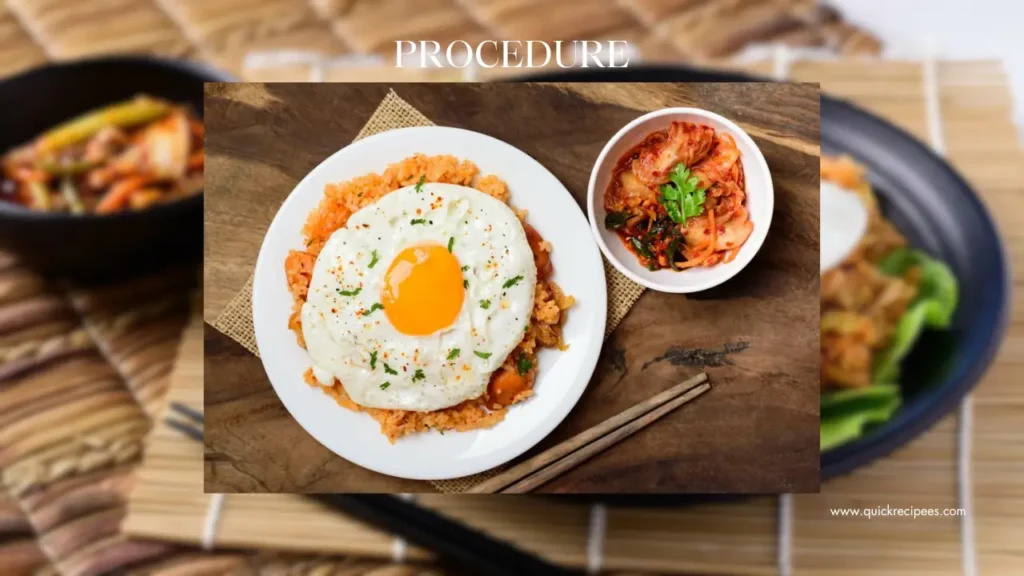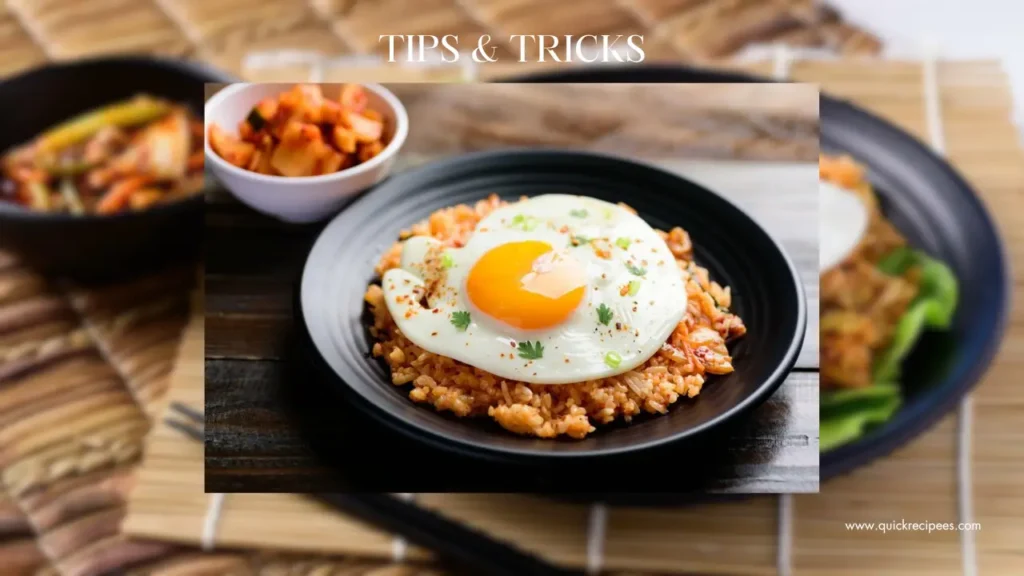Kimchi eggs are a simple, delicious Korean side dish or snack made by sautéing kimchi and eggs together. This flavorful dish beautifully combines the spicy, umami flavors of well-fermented kimchi with soft, fluffy scrambled eggs.
The origins of kimchi eggs can be traced back to Korean home cooks looking for an easy way to use up older kimchi in the refrigerator. The eggs act as a perfect foil for strong-tasting, funky kimchi, mellowing out the sharp edges while still allowing the kimchi’s flavor to shine.
This easy kimchi egg recipe is endlessly adaptable and customizable based on what type of kimchi you use and any additional mix-ins you fold in. Feel free to experiment with green onion kimchi, radish kimchi, or cabbage kimchi, depending on your preferences. You can also add extra vegetables, meats, cheeses, or spices to make this humble dish your own.
Read on for an introductory kimchi egg recipe along with pro tips and tweaks for bringing this flavorful Korean staple to your breakfast, lunch, or dinner table. Once you get the basic method down, let your imagination run wild. Discover more innovative and delightful breakfast ideas in our Breakfast Category.
Kimchi Eggs Recipe
Equipment
- Small non-stick skillet
- Spatula
- Mixing bowl
- Fork or chopsticks for beating eggs
- Plate or bowl for serving
Ingredients
- 3 eggs
- 1 cup kimchi chopped
- 1 teaspoon sesame oil
- One teaspoon of neutral cooking oil like vegetables canola, etc.
- Salt and pepper to taste
- Green onions chopped, for garnish (optional)
- Gochugaru Korean chili flakes for garnish (optional)
Instructions
Here are some key tips for mastering the method:
- Beat the eggs gently to avoid incorporating excess air
- Chop the kimchi into small, consistent bite-size pieces so it cooks evenly
- Use a non-stick pan over medium heat for easier sautéing
- Stir the eggs frequently as they cook to form soft, delicate curds
- Avoid overcooking or browning the eggs
- Season assertively with salt and pepper to balance the kimchi
- Adjust the spice level by adding more aged kimchi or gochujang chili flakes
- Enjoy the kimchi eggs warm immediately after cooking for the best texture
Notes
Procedure: Step-by-Step Kimchi Egg Recipe

- Crack 3 eggs into a mixing bowl, season with a pinch of salt and pepper, and beat lightly with a fork or chopsticks until just blended, about 10-15 strokes. You don’t want to incorporate too much air.
- Chop 1 cup kimchi into bite-size pieces. Any mature, strongly flavored kimchi will work well. For beginners, napa cabbage kimchi is a good place to start.
- Heat a small non-stick skillet over medium heat. When hot, add 1 teaspoon of neutral cooking oil and 1 teaspoon of sesame oil.
- When the oil is shimmering, add the chopped kimchi and sauté for 1 minute to heat through.
- Pour in the beaten eggs. Using a spatula, gently push, lift, and fold the eggs from the bottom of the pan, allowing any unset egg to flow underneath. Think of it like making soft scrambled eggs with the kimchi mixed in.
- Continue cooking, stirring gently and frequently, until the eggs reach your desired consistency, 1-2 minutes for soft, creamy curds or up to 3-4 minutes for firmer, more set curds.
- Remove the pan from the heat. Taste and season to your preferences with more salt, pepper, or additional kimchi.
- Transfer the kimchi egg mixture to a plate or shallow bowl. Garnish with chopped green onions and gochujang chili flakes if desired. Enjoy immediately while the eggs are hot and fluffy.
Tips and Tricks for Next-Level Kimchi Eggs

Use Very Flavorful Kimchi
The bolder, funkier, and more pungent your kimchi is, the better your kimchi eggs will taste. The assertive kimchi flavor is meant to stand out against the mild, tender egg curds. For best results, use very ripe, well-fermented kimchi packed with tangy, spicy umami flavor.
Sauté the Kimchi First
Heating the kimchi before adding the eggs deepens the flavors even further. Let the kimchi caramelize slightly by sautéing it on its own for 1-2 minutes before pouring in the beaten eggs. This extra time on heat concentrates the tastes for an even bolder result.
Splash in Some Kimchi Juice
For a flavor boost, you can add a tablespoon or two of kimchi liquid straight from the jar along with the chopped kimchi itself. The salty, fermented brine provides the perfect zingy finish.
Mix and Match Kimchi Varieties
Playing around with different kimchi varieties keeps things interesting. Some delicious combos include green onion kimchi with cabbage kimchi, radish kimchi with cucumber kimchi, or even kimchi slaw mixes paired with traditional napa cabbage kimchi.
Spice It Up
Suppose you want to turn up the heat beyond your kimchi’s inherent spice level. In that case, you can sprinkle the finished kimchi eggs with Gochugaru. Korean chili flakes, gochujang Korean chili paste, or your favorite hot sauce.
Take It Over Easy
For fun texture contrast, try cracking a whole egg directly into the pan after sautéing the kimchi, then gently basting the hot kimchi and oil over the egg white. The runny yolk mixed with spicy kimchi when you break it open makes for extremely good eating.
For more culinary insights and helpful cooking advice, explore our Kitchen Tips Section for a range of useful techniques and ideas.
FAQs About Kimchi Eggs
What type of kimchi is best for kimchi eggs?
The ideal kimchi has aged for at least 1-3 months and has a very ripe, funky, fermented flavor that stands up boldly against the rich eggs. Fully fermented napa cabbage kimchi is a perfect place to start.
Is it necessary to chop up the kimchi?
Chopping makes for easier, more cohesive cooking. The kimchi pieces should be cut into bite-size pieces roughly 1/2 to 1 inch in size before adding to the skillet with the eggs.
What’s the best cooking method and temperature?
For tender curds, use a non-stick skillet over medium heat. Cook while pushing and folding the eggs continuously to allow steam to escape rather than puffing them up excessively.
How is the dish typically served?
Kimchi eggs are usually enjoyed warm, straight out of the pan, garnished with sliced green onions or chili flakes. For breakfast, serve it like scrambled eggs with rice and banchan sides.
What other ingredients go well stirred into the basic recipe?
Some delicious mix-in options are wilted spinach, corn kernels, carrots, potato, sweet potato, tofu, melted mozzarella cheese, ham, bacon, sautéed mushrooms, onions, and zucchini. The possibilities are endless!
Conclusion
From its humble beginnings as a homemade kitchen invention to its growth into a beloved Korean comfort food staple, kimchi egg is a dish that celebrates the unique alchemy between simple ingredients. All it takes is salted, fermented kimchi meeting fluffy eggs in a hot skillet to create a quick, tasty side or snack that plays on the harmony of contrasting textures and flavors.
Part of the enduring appeal of this easy kimchi egg recipe is how adaptable it is to cooks’ tastes. As your palate becomes accustomed to the chili-infused twang of well-aged kimchi, try seeking out funkier, more pungent varieties each time to keep taking your eggs up a notch. Or add fresh contrast by folding in sweet corn kernels, crunchy julienned carrots, soft tofu cubes, tender wilted spinach, and melty cheese—the only limit is your imagination.
Once you have the basic kimchi egg formula memorized, embrace it as a template inviting creativity rather than a strict recipe. Let individual kimchi ingredients sing loud and proud against a lush egg backdrop, or increase the complexity by weaving in layers of contrasting flavors and textures.
However, if you choose to make it your own, kimchi eggs represent the spirit of Korean cooking and the promise of transforming humble pantry staples into something unexpectedly special. Each bite celebrates how sour and spice, crunch, and cream can come together to build a flavor greater than the sum of its parts.


